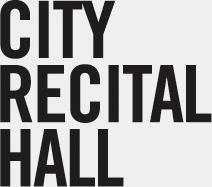



The Lost of Pubs of Surry Hills
The Changing Face of Central Sta-
Satirical Mural Painter Scott Marsh
Meet the team at Sydney Funeral Co
Cream of the Crop Immersive Arts
ENTERTAINMENT
What’s Happening in Your Area?






The Lost of Pubs of Surry Hills
The Changing Face of Central Sta-
Satirical Mural Painter Scott Marsh
Meet the team at Sydney Funeral Co
Cream of the Crop Immersive Arts
What’s Happening in Your Area?

WELCOME to 2010 Issue #8. We take a trip down memory lane and reflect on the Surry Hills + Darlinghurst Pubs that we’ve loved and lost over the years. We have a long overdue catch-up with prolific Australian satirical artist Scott Marsh, to chat about life and his latest mural in Darlinghurst, which caused quite a stir with the Swifties.
We also meet some incredible local businesses: the team at ADGE Hotel & Residences, and the Sydney Funeral Co. Then it’s all about Arts - we have a great What’s On Guide and checkin with Belvoir Theatre to hear about their upcoming season of The Curious Incident of the Dog in the Night Time. There’s some more history, community news, true crime and our fabulous Local Business Directory. Dig in!
The Neighbourhood Media Team x
Belvoir presents The Curious Incident of the
PUBLISHER - Neighbourhood Media
DESIGNER - Robert Everett
CONTRIBUTORS - Isabella Edwards, Corina Harvey, Jamie Apps, Robert Everett, Rita Bratovich, Alec Smart & Elliot Lindsay
ADVERTISING - Georgie Pengelly - 0416 972 081
The Brand New ADGE Hotel & Residences
The Steady Decline of Local Pubs

The Surry Hills Stocking Murderer
There is no better time to shop local, make sure to show your support

By Elliot Lindsay

PSurry Hills, a unique inner-city suburb of Sydney, is renowned for its vibrant cafe scene, boutique shops, picturesque terraced streets, and a remarkable number of pubs.
PUBS, a cornerstone of Surry Hills’ village culture, are a distinct feature of the area. Surry Hills stands out with a current count of twenty-two, particularly when compared to the average Sydney suburb, which typically has no more than two pubs. However, this number represents a significant decline from the past.
Since 1833, Surry Hills has been home to a total of ninety pubs, inns, taverns, and hotels, reaching its peak at eightythree open at the same time in 1889! Streets like Fitzroy, Riley, and Devonshire were particularly known for their pub culture, boasting six, nine, and ten establishments respectively. But what led to the closure of sixty-nine of these iconic establishments?
It is crucial to delve into the history of the hotel industry in the area. The first hotel, Roebuck’s Inn, opened its doors in 1833 at what is now 360 Bourke Street (long since demolished). Inns like Roebuck’s were not just places of lodging but also served as stables for horses and venues for meetings, making them vital during colonial times.
A handful of hotels were erected in the 1830s and 1840s; The Surry Hills Hotel on Elizabeth Street still operates today, albeit not in the original building. Established in 1845, it is the longest-running hotel in Surry Hills.
The gold rush in New South Wales spurred significant urban development in Surry Hills, which began in the 1850s. This period witnessed a surge in Sydney’s population and the expansion of its suburbs. Farms in Surry Hills were
subdivided into streets, lanes, cottages, and terraces, with new residents increasing demand for new pubs.
Between the 1850s and 1860s, eighteen more hotels opened, including notable names like The Dolphin (1856), The Clock (1864), and The Evening Star (1866).
The 1870s and 1880s brought exponential growth and economic prosperity to Surry Hills, shaping it into the town recognised today. Many of the popular pubs operating today, such as The Beresford (1870), The Royal Albert (1873), The Shakespeare (1879), and The White Horse (1880), were established during this period. However, by this time, authorities deemed eighty-two pubs sufficient for the neighbourhood, halting the issuance of new licenses.
Sydney lacked adequate mortuary facilities during the nineteenth century. The North Sydney Mortuary, built in 1853, and the South Sydney Mortuary, established in 1882, could not handle the capacity. Consequently, all the local pubs in Surry Hills served as temporary mortuaries where bodies awaiting coroner inspections were stored.
Inquests were also held in these pubs, making them more than just places for drinking and lodging. This was an old English custom dating back centuries.
The demographics of Surry Hills underwent a significant shift after the 1890s depression. The area saw an exodus of wealthier residents, who were replaced by a rural underclass. The landscape of Surry Hills transformed, with factories replacing residential blocks, leading to a decline in

living conditions.
The Liquor Act of 1916, which introduced the six o’clock swill, further reshaped the pub scene. Big breweries like Tooths & Co, Toohey’s, and Resch’s acquired and renovated most hotels to cater to the working-class clientele who flooded pubs between 5 pm and 6 pm.
The New South Wales Government actively inspected and terminated pub licenses in the early twentieth century. Seven pubs had already been closed during the 1890s depression, and eight more were terminated in the early 1900s. The most significant closures occurred between 1920 and 1924, when twenty-eight licenses were revoked.
By the beginning of the new millennium, thirteen more pubs had closed, the latest being The Hopetoun in 2009. Of the closed pubs, thirty-eight were demolished.
The former hotel buildings that survived were repurposed into boarding houses, shops, brothels, warehouses, and workshops. When the baby boomers moved to Surry Hills from the outer suburbs, starting in the 1970s, the area was gentrified. Many old pubs were converted into houses and apartments.
Intriguingly, many people today live in buildings that were once bustling pubs from over a century ago and have no idea of their home’s history. We walk along the streets and lanes of Surry Hills, passing these historical buildings, oblivious to their glorious past. They are hidden before our eyes; they are ghosts in plain sight.






Sydney’s Central Station is NSW busiest station with more than 250,000 passengers passing through its turnstiles daily.

FFIRST opened on August 4, 1906 and located on the doorstep of Surry Hills and the Sydney CBD, Sydney’s Central Station initially replaced the previous Sydney Terminal Station, which had become unable to handle the growing rail traffic. This new station was designed to serve as the central hub for both suburban and long-distance trains, reflecting the city’s incredible expansion and growing demand for efficient public transport.
The station’s original design featured a grand sandstone facade, with a clock tower that became a prominent landmark in the city. It was built on the site of the Devonshire Street Cemetery, which was relocated to make way for the new transportation hub.
As Sydney continued to grow, so did Central Station. The 1920s and 1930s saw significant expansions, including more platforms and tracks to accommodate increasing passenger numbers. The electrification of the Sydney suburban rail network, which began in the late 1920s, further enhanced the station’s efficiency. The 1960s and 1970s saw the introduction of an underground concourse and more streamlined connections between different modes of transport.
In the late 20th and early 21st centuries, significant modern upgrades were introduced, including improved accessibility for people with disabilities, and the introduction of electronic ticketing systems. The construction of the Airport Link in the 1990s provided a direct rail connection to Sydney Airport, which revolutionised Sydney-siders’ commutes to the airport.
The early 2000s saw the refurbishment of heritage-listed parts of the station and the expansion of retail and dining
options within the concourse. These improvements aimed to enhance the passenger experience and accommodate the growing number of daily commuters.
Today, Central Station is undergoing a major transformation as part of the broader Sydney Metro project. The Central Precinct Renewal Program’s vision is to renew the 24 hectares of land in and around Sydney’s Central Station into an exciting place for business and the community.
This ambitious initiative includes the construction of new underground platforms for the Sydney Metro City & Southwest line, which will significantly increase the station’s capacity and reduce congestion. The project also involves upgrading existing infrastructure, such as refurbishing platforms and improving pedestrian flow within the station.
One of the most significant planned developments is the Central Walk, an underground concourse that will provide a direct link between the suburban platforms and the new metro platforms. Scheduled for completion in the mid2020s, Central Walk aims to streamline the transfer process for passengers and enhance connectivity within the station. Future plans for Central Station also include the potential development of over-station buildings, incorporating commercial, retail, and residential spaces.
You can find more information on the Central Precinct Renewal Program online: transport.nsw.gov.au/projects /current-projects/central-precinct-renewal-program

By Alec Smart
Artist Scott Marsh is (in)famous as both a talented mural painter – with vibrant, detailed artworks gracing walls across Sydney – and a spikey satirist commenting on contemporary social issues with a razor-sharp wit that takes no prisoners.
AMONG the latter, his targets have included hilarious caricatures of Scott Morrison, Anthony Albanese, Gina Rinehart, Tony Abbott, Alan Jones and Cardinal George Pell.
ASeveral of his pointed political portraits grace the walls of inner-Sydney suburbs, including Newtown, Enmore, Chippendale, Erskineville, Redfern and Alexandria. One of his most recent and ironically famous murals is a dynamic image of iconic American pop star Taylor Swift. In close proximity to Taylor Square, the artwork appears on the side wall of Rivareno Gelato at the corner of Little Oxford St and Crown St, Darlinghurst.
Despite his diverse portfolio of public works, his reputation is more of a satirist than a painter of icons of popular culture. So how did the Taylor Swift mural come into being?
“Well, it was a satirical work of sorts,” Scott explained, “or at least a troll and experiment to highlight the failures of mainstream media and the plight of Julian Assange, who had his final USA extradition appeal at the time I painted it.”
Scott put it into context in an Instagram post on 21 February 2024: “On the day of the final appeal for Australian citizen and award-winning journalist Julian Assange’s extradition to the USA for the crime of journalism - publishing truthful information about USA war crimes (for which he faced 175 years in a US prison, essentially a death sentence).… In the morning when I turned on the news, what did I see on every channel: ‘Taylor Swift has dinner in Surry Hills’!!”
Taylor was in the midst of her Eras Tour, which involved 152 concerts across five continents, including four sold-out performances at Accor Stadium in Sydney, the final attracting over 80,000 fans - and became the highest-grossing tour in history earning $1 billion in revenue.
Scott elaborated, “This is a mural of Taylor Swift but not really about Taylor Swift, It was more an experiment to show where media’s priorities lie. Using the metaphor of ‘The
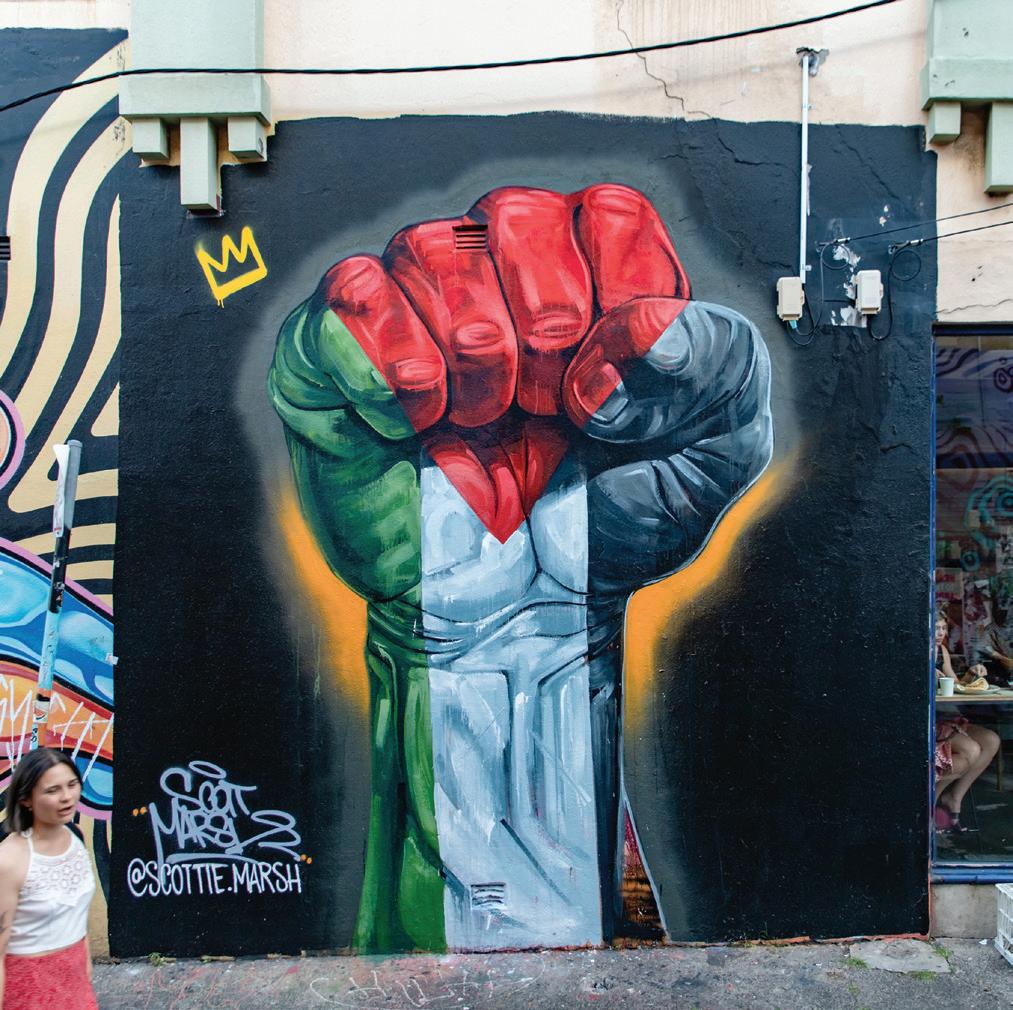
woman in the red dress’, the idea that ‘The System’ distracts the people with one hand (‘Hey look at this beautiful woman in the red dress!’), while it commits despicable acts against the people with the other hand.
“In the past year I have painted well-thought-out and executed murals about Julian Assange, Covid origins/vaccines’ injuries and the Palestine/Israel conflict, yet despite serious attempts being made, cannot not get any meaningful mainstream media coverage of those works.
“I paint a mural of Taylor Swift and before it’s even finished, my inbox is full of media requests, it has been syndicated, and is appearing in a dozen online outlets, in print, TV and radio.
“So, that was the experiment and it really worked a treat!”
Scott declared, “Conceptually it’s actually one of the works I’m most proud of.”
How does he go about selecting the walls for his murals? Do people contact him and offer their houses?
“Either people contact me and say, ‘Hey, I have a wall that’s free for you to paint’, or, ‘I would like to commission you to paint my wall,’” he said.
“Alternatively I find a wall I really like and knock on their door and ask if I can paint it. If it’s commissioned I’ll get it done pretty quick, if it’s not, I wait until I have a work I would like to create in that space. The perfect wall for my work is 1.5 - 3 stories, minimal windows, pipes or drains, and is a spot that gets at least a little foot traffic.”
As a painter, how did he transition from canvases to walls, and from art pieces and tributes to satirical works criticizing injustice and political scandals?
“I have been painting graffiti since I was 12 years old,” he revealed, “so when I started moving into more pictorial work, painting walls came naturally… I have a bit of a scatter-brain so I think painting the same thing or within a specific genre would drive me nutty, so I bounce around

between portraiture, satire, still-life’s etc.”
Controversially, a few of Scott’s satirical murals, such as those featuring George Michael and George Pell, have been vandalised by enraged individuals, typically religious fundamentalists. Furthermore, a Redfern mural featuring a burning police car and commemorating Indigenous youth TJ Hickey, who died in mysterious circumstances in 2004, was ordered to be covered over by NSW Police.
This must be really disappointing, considering the hours it takes to create his detailed artworks, and that they’re painted with the permission of the householders. How does the vandalism make him feel?
“Some people have very thin skin and want to destroy things they don’t like,” Scott considered. “It’s always disappointing when my works get trashed but as long as I have a good image of the work, I’m not too devastated. A lot of my work finds its audience in a digital space rather than a physical one, so if I have a good image of the work it lives forever, indestructible online.
“Ironically in every case to date when a mural is destroyed it blows up online and in the media, and is seen by 10000s more eyeballs, so it’s pretty counter-productive for the d***head who destroyed the original artwork!”

16 Foster Street, Surry Hills
High-intensity, low-impact workout that combines elements of strength training, cardio, and flexibility. Sculpt muscles, improve endurance, and enhance overall fitness levels



“Some people have very thin skin and want to destroy things they don’t like,”





Meet
SSCOTT DUNCOMBE, founder of Sydney Funeral Co., has always been deeply involved in all aspects of his business - operations, logistics, arrangements, and ceremonies. In his opinion, it is a significant honour for families to place the trust in him that they do, which he cherishes.
Some larger companies lack clear communication, with families often dealing with multiple contacts and chasing up answers to important questions. Sydney Funeral Co offers the opposite experience, with Scott being present at every funeral and being directly available to clients.
“As the owner I am also very passionate about holding a certain standard, which shouldn’t come at a cost to families, but rather just be the norm.”
Sydney Funeral Co operates throughout Sydney and extends from the Central Coast to the South Coast, the Southern Highlands to the Blue Mountains. And these guys definitely aren’t Monday to Friday type funeral directors; if you want a sunrise or sunset service, a service by the water, a service in a national park, night club, pub, bowls club or anywhere a little different, then it’s their mission to make it happen. “We are all about pushing the envelope when it comes to funerals”.
THE INCEPTION OF SYDNEY FUNERAL Co.
In May 2020, Scott identified a gap in the market for premium funeral services at affordable prices, and thus Sydney Funeral Co was born. The company’s unique approach involves itemising every cost element without
any commissions or mark-ups, ensuring full transparency for families. This straightforward pricing model eliminates surprises and allows families the option to choose their own service providers for elements like floristry or coffin making.
The team at Sydney Funeral Co. is diverse, made up mostly of celebrants who specialise in ceremony and storytelling. As a celebrant himself, Scott understands the importance of honouring a person’s life through stories.
The office is managed by George, an 83kg Newfoundland dog who brings comfort and joy to everyone he meets. Additionally, Ben Gibson, an End of Life Doula, supports families during the final stages of a loved one’s life, providing invaluable guidance and care.
The entire team strives to make the entire funeral planning process less daunting for families. They advise families to take their time making decisions, offering the option to preselect elements like coffins and flowers before finalising legal paperwork.
Approximately 80% of families opt for this approach, finding it stress-free. The company’s transparent pricing model, which includes passing on wholesale coffin prices to families, helps alleviate financial concerns.
Planning a funeral can be one of the most challenging experiences a person can go through with numerous details
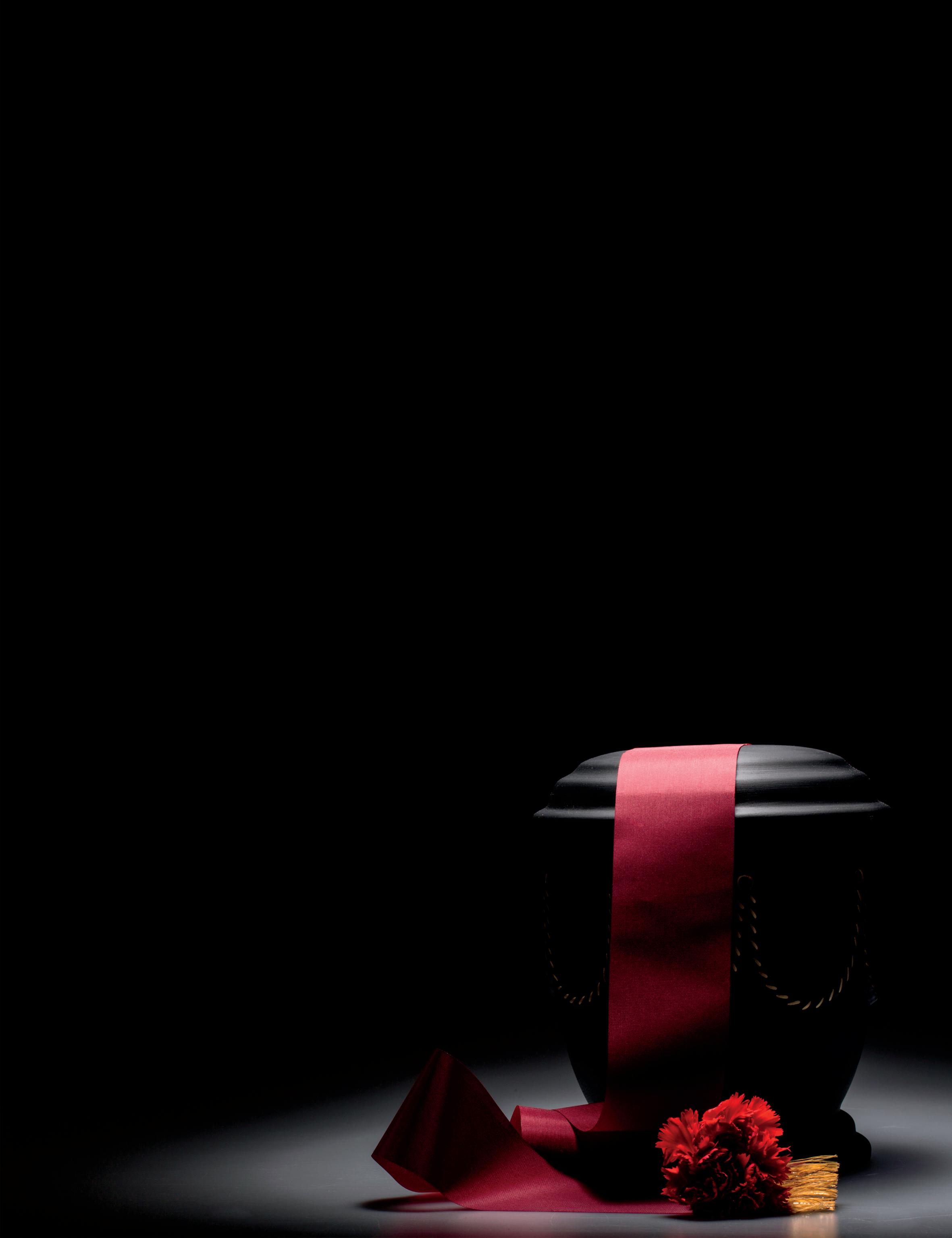

needing to be organised in a short period of time. Sydney Funeral Co. handles everything, and we mean everything. From live-streaming and AV equipment to catering and musician arrangements. This comprehensive service allows families to focus on what’s important; their loved ones and their community during this difficult time.
Sydney Funeral Co. is also able to ease the financial challenges a funeral can create. Their pricing model and services are designed to prevent families from experiencing regret over their choices. There are also prepaid funeral plans and crowdfunding options available. The Tap a Little Contribution initiative allows friends and family to contribute to funeral costs, the wake, or a chosen charity (there are no admin fees, and all monies donated go to the nominated purpose/cause). This has been a game-changer for many families.
Death can be expensive, with funerals ranging from $2,000 to more than $80,000. The Tap a Little Contribution emerged from the need for a service that allowed funeral attendees to offer financial support, similar to wedding wishing wells. Scott, who is also a Wedding Celebrant, told us, “As a wedding celebrant, I see so many weddings where people donate money into the wishing well and it is totally acceptable to ask/receive money. However when it comes to death, no one ever asks, and no one ever offers to contribute, but everyone expects a sandwich at the wake”.

The Tap a Little Contribution initiative relieves families of some financial stress, especially in cases of a sudden or unexpected death. For example, if 100 people each donate $100, the family receives $10,000, significantly easing their burden.
One family’s daughter passed away unexpectedly due to an undiagnosed health condition; the family were completely devastated and in shock. In their grief, they wanted to organise a beautiful send-off for her but faced financial strain. Through the Tap a Little Contribution, they raised over $10,000, allowing them to honour their daughter in the way they wanted without incurring debt. This experience brought immense relief and gratitude to the family.
If you, or someone in your community, is faced with the unexpected burden of planning a funeral, Sydney Funeral Co. will always provide a compassionate, transparent, and innovative service, ensuring that every life is honoured with dignity and respect. You can find more details online at www.tapalittlecontribution.com.au

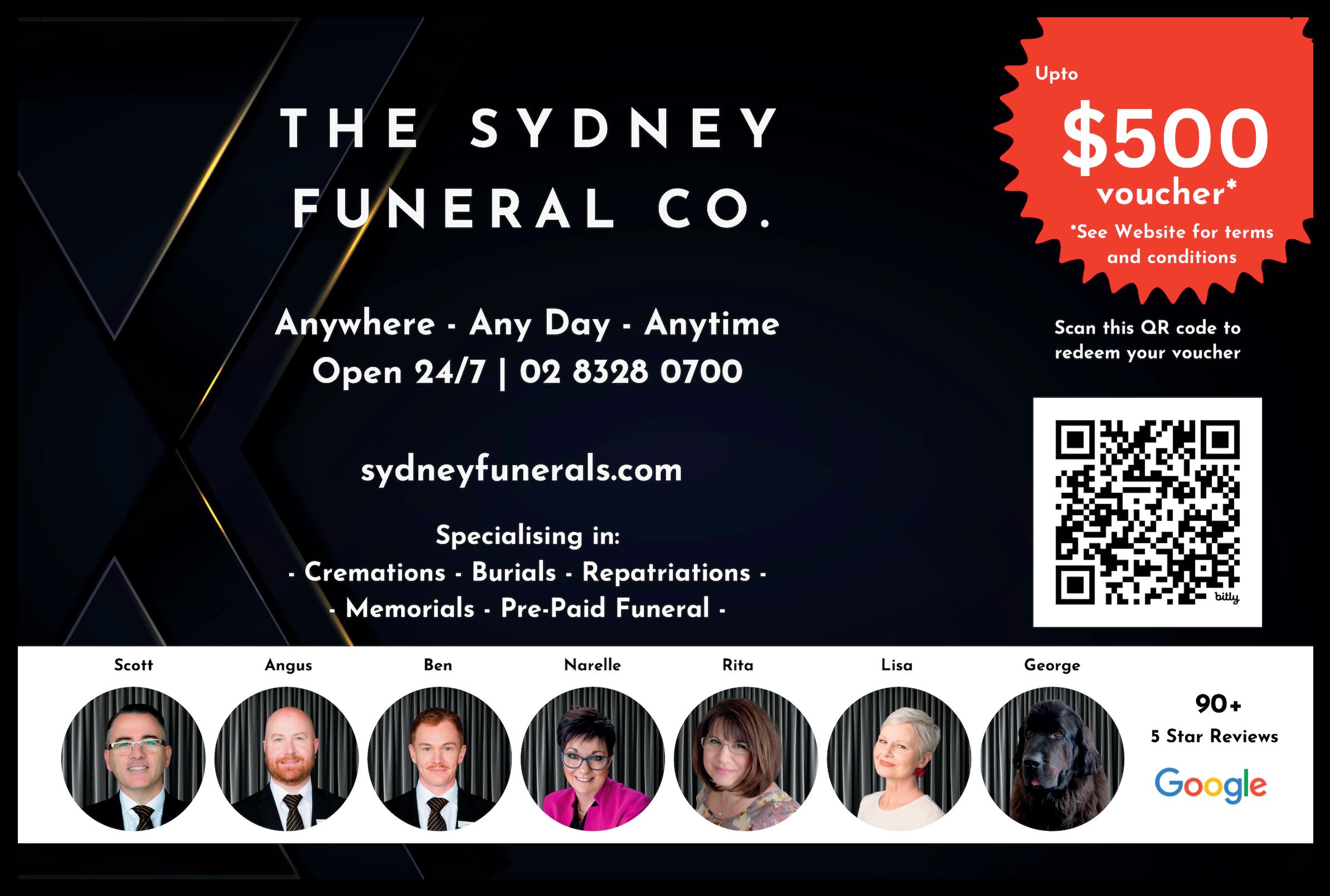
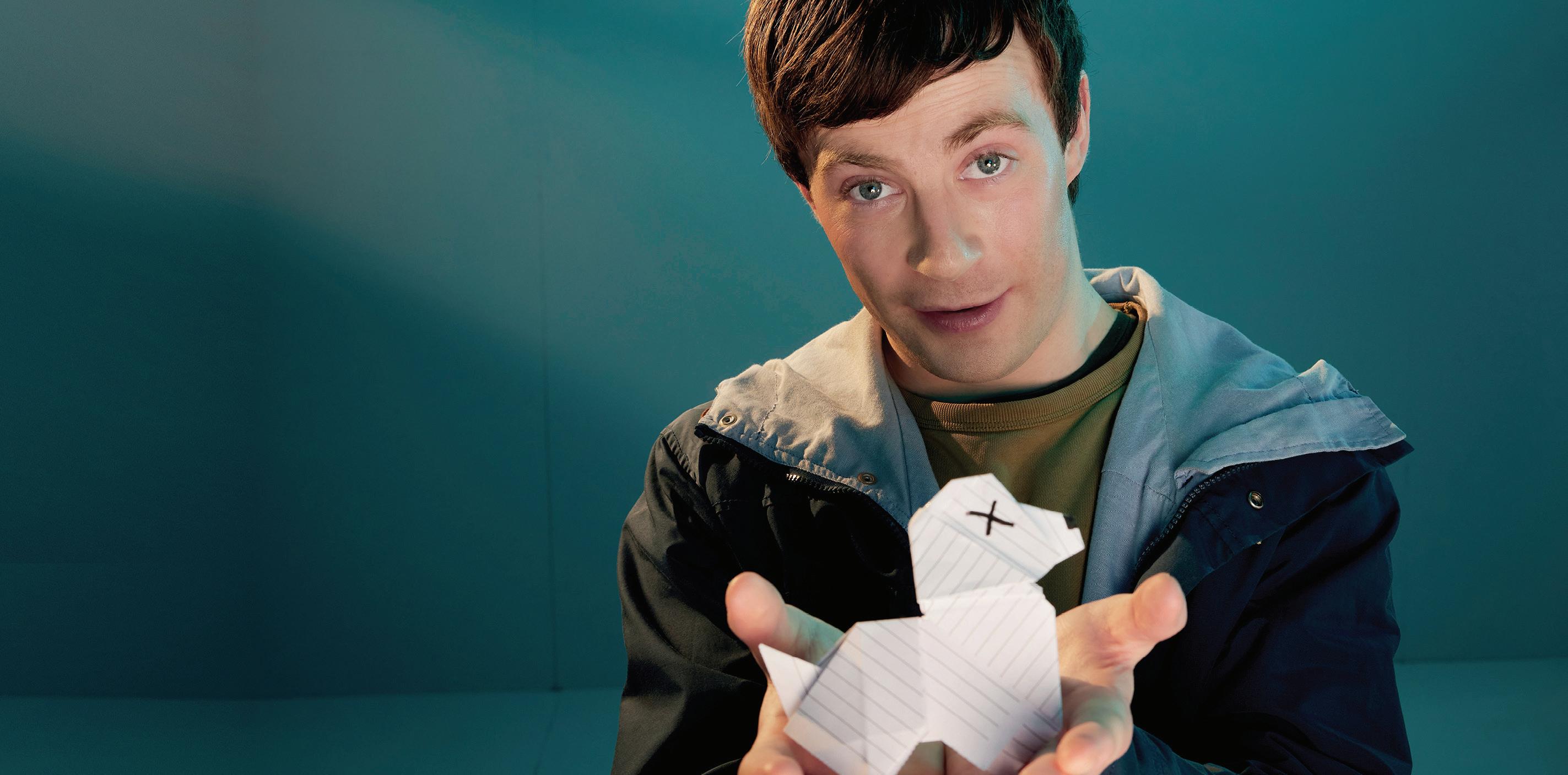
Based on the novel by
Mark Haddon
Adapted by Simon Stephens
Belvoir St Theatre presents a brand-new staging of Simon Stephens’ Olivier and Tony award-winning adaptation of Mark Haddon’s bestselling novel, The Curious Incident of the Dog in the Night-Time.
CCHRISTOPHER BOONE, fifteen years old, is an extraordinary thinker. He’s exceptional at maths and observes things nobody else sees. Everyday life is a little trickier – he has never ventured alone beyond the end of the street, he detests being touched, and he’s wary of strangers.
Now he’s in the front yard, it’s seven minutes to midnight, and Mrs Shears’ dog is lying dead at his feet, a garden fork in the neck. He’s going to be the chief suspect, isn’t he? So who can solve the mystery? Nobody but Christopher, and what he uncovers takes him on a journey that even he couldn’t have predicted.
Mark Haddon’s best selling novel, The Curious Incident of the Dog in the NightTime took the literary world by storm when it was first published in 2003. His unique narrative writing style invited readers into the mind of 15-year-old Christopher, to see the world as he does - logical, detailed, and sometimes a bit different.
joys of Belvoir is finding fabulous theatrical solutions to the demands of a story.” The company presents a brand new staging of this part-detective story, part-family drama, partadventure production, uniquely for this corner stage. With accessibility at the forefront, audiences can look forward to a sensory-friendly experience, while experiencing what the full story has to offer.
‘‘Mark Haddon’s best selling novel, The Curious Incident of the Dog in the Night-Time took the literary world by storm.’’
Director of the production, and Belvoir’s Resident Director, Hannah Goodwin, said, “The challenge that the play poses is that it’s our differences that unite us not divide us. I’m really excited to bring this show to Belvoir because I think we can make a version of it here that we couldn’t make anywhere else. I read this book when I was a teenager and loved it. I’m hoping to see some young people experiencing this story for the first time at our show.”
What Mark Haddon thought was an unadaptable book for the stage, Simon Stephens proved otherwise. A dramatized narration of his account, read through his teacher, Siobhan. An innovative way of externalizing Christopher’s thoughts, making this production a story within a story.
Artistic Director Eamon Flack said, “One of the great
A story of empathy and acceptance, relationships, and understanding of the world, The Curious Incident of the Dog in the Night-Time is led by a cast of 8. Featuring Nicholas Brown, Tracy Mann, Brandon McClelland, Daniel R. Nixon, Matilda Ridgway, Ariadne Sgouros, and Brigid Zengeni.
It’s a show about family, about courage, resilience and the power of imagination. Join Christopher on the journey of a lifetime, through his lens of the world, right here in Surry Hills.








The locals in Surry Hills, Darlinghurst and Inner Sydney are a talented bunch, check out these incredible events coming up in the next few months.
TWOFOLD (Sept 18 - 28)
Roslyn Packer Theatre, 22 Hickson Rd, Walsh Bay
A monumental double bill featuring the return of Rafael Bonachela’s beloved Impermanence alongside a world premiere of Love Lock by renowned choreographer Melanie Lane. Impermanence, a visceral and thrilling exploration of the juxtaposition of beauty and devastation, features an evocative score by Grammy Award-winning composer Bryce Dessner, performed live on stage by a string quartet. Love Lock re-imagines folk dance with music by renowned artist Clark and costumes by the acclaimed Akira Isogowa.
Book your tickets online: sydneydancecompany.com/ performance/twofold
(Sat + Sun)
Shaffa, 80 Albion St, Surry Hills
Enjoy an à la carte menu or an ever-popular weekend brunch feast featuring Middle Eastern delights, like the home-made Jerusalem bagel, musabbaha and chicken shawarma - all for only $79 per person. Treat yourself and go bottomless with the 90 minute drinks package including free-flowing rose Goldstar beer and margaritas! For more details and bookings head to shaffa.com.au
ALAM (Aug 23 - Oct 6)
4A Centre for Contemporary Asian Art, 181-187 Hay Street, Haymarket
In collaboration with Arts House (Melbourne), 4A Centre for Contemporary Asian Art is co-commissioning an immersive exhibition by Hazara artist Elyas Alavi. Alavi’s ALAM unfolds through a rich tapestry of symbols, phrases, poetry, faces, body language and community codes, serving as profound reflections on queer Muslim diasporic communities.
Each Alam resonates with references to significant events, highlighting historical and contemporary figures who bravely advocated for their sexual identity and those who tragically lost their lives due to their sexuality.

Innit Cafe & Bar, 54-58 Foveaux Street, Surry Hills
Omakase - a Japanese phrase, used when ordering food in restaurants, means ‘I’ll leave it up to you’. Let Innit Cafe & Bars’ Master Mixologist take you on an incredible journey through a curated selection of handcrafted cocktails. The $99 package offers a private dining experience with your own dedicated bartender who will deliver 6 x cocktails, with 6 x food pairings. To book your experience, head to innitcafeandbar.com
AMBIVALENT WOMAN OF 37 (Sept 10 - 14)
Flight Path Theatre, part of Sydney Fringe Festival
Emma Sandall’s new show, premiering at the Sydney Fringe Festival from the 10th-14th September at the Flight Path Theatre in Marrickville, delivers its audience to the heart of a woman’s struggle to make the mother of all decisions: whether or not to have a child. There are few decisions more subject to the opinions and judgements of others. An Ambivalent Woman of 37 responds to them all. And it’s funny, and sad. Based on Sheila Heti’s New York Times best-selling novel Motherhood, the cabaret-style show Emma Sandall has created and performs serves up a thrilling collision of animation, music and choreography with an original score by Elena Kats Chernin AO, performed by pianist Yanghee Kim.
Book online: sydneyfringe.com/events/an-ambivalentwoman-of-37
Image credit: Marnya Rothe


Grand Electric Theatre, 199 Cleveland St, Surry Hills
From the creators of Blanc De Blanc, Limbo will take you on a journey into the artistic underworld. The show is an intoxicating mix of cabaret, circus, acrobatics and heart-pounding LIVE music - performed by an incredible cast of world-renowned circus performers and musicians; led by NY’s Jank maestro, Sxip Shirey, alongside Grant Arthur and Mick Stuart. If you’re looking for a show of epic proportions don’t miss the final weeks!
Book online: strutnfret.com/grand-electric/limbothe-return-sydney
(Sept 27 - Oct 19)
Seymour Centre, Cnr City Rd & Cleveland St, Chippendale
What did it feel like when you were seventeen? What’s it like to be seventeen now?
Joyful and profound, Matthew Whittet’s Seventeen tells the story of a group of high school students experiencing something we all remember well, the last day of school – forever. All roles are performed by older actors who were seventeen many years ago, bringing the experience of age to the dreams of hopeful youths. Who says you’re only young once? Matthew Whittet’s play is all at once knowing, innocent and deeply moving.
Book online: seymourcentre.com/ event/seventeen

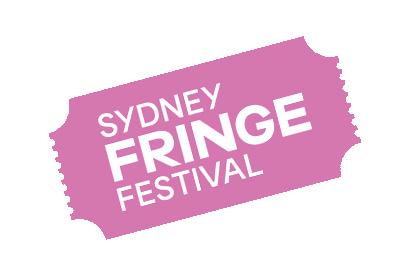





(Nov 7 - 24)
Seymour Centre, Cnr City Rd & Cleveland St, Chippendale
Matthew Lopez’s epic play, The Inheritance, reimagines E.M. Forster’s Howards End as a contemporary portrait of New York’s gay community. A story of survival, legacy and love, The Inheritance investigates a circle of friends attempting to forge a future for themselves amid a turbulent and changing America. Following hit seasons on the West End and Broadway, four Tony and four Olivier Awards including Best Play, this twopart epic makes its Sydney premiere at Seymour Centre this November.
Book online: seymourcentre.com/ event/the-inheritance
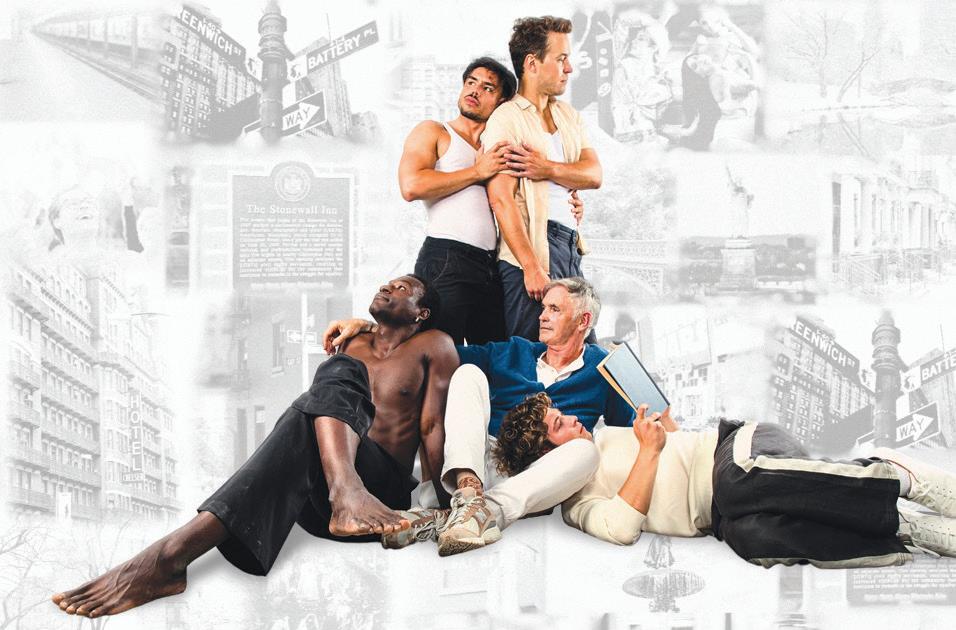

ON - THE
(Sat, Nov 30)
(Sat, Nov 30)
City Recital Hall, Angel Place, Sydney
City Recital Hall, Angel Place, Sydney
The Whitlams take the stage to celebrate the 25th anniversary of the double platinum album, Love This City, and write a new chapter in its storied history on the City Recital Hall stage.
The album was the ambitious big-budget follow up to the award-winning Eternal Nightcap, and its reputation has gathered steam over the years, recently being named in Rolling Stone’s Best Australian Albums of All Time list last year at no. 101.
The Whitlams take the stage to celebrate the 25th anniversary of the double platinum album, Love This City, and write a new chapter in its storied history on the City Recital Hall stage. The album was the ambitious big-budget follow up to the award-winning Eternal Nightcap, and its reputation has gathered steam over the years, recently being named in Rolling Stone’s Best Australian Albums of All Time list last year at no. 101.
Tim Freedman will be joined by long term cohorts guitarist Jak Housden and drummer Terepai Richmond, who were both part of the sessions back in 1999, with new member, multi-instrumentalist Ian Peres. It will be an evening of memories, milestones and humour as the band delivers its usual rambunctious performance, complete with the power of brass. Come join the band at City Recital Hall where you will be inspired to party like it’s 1999.
Tim Freedman will be joined by long term cohorts guitarist Jak Housden and drummer Terepai Richmond, who were both part of the sessions back in 1999, with new member, multi-instrumentalist Ian Peres. It will be an evening of memories, milestones and humour as the band delivers its usual rambunctious performance, complete with the power of brass. Come join the band at City Recital Hall where you will be inspired to party like it’s 1999.
Tickets: cityrecitalhall.com
Tickets: cityrecitalhall.com.




BBETWEEN Crown Street and Elizabeth Street runs Reservoir Street, a stretch of Sydney’s trendy Surry Hills, today adorned with charming terraces and converted factories now serving as luxury apartments and office suites. Yet, in the 1930s, during the Great Depression, Reservoir Street was a hub of industrial activity. The area’s houses were dilapidated, and its streets, marked by soot and grime, echoed with the sounds of trucks transporting goods such as cured meats, chemicals, clothing, textiles, and paper products. The dark, narrow lanes were cloaked in smoke, winding through piles of decaying refuse. Razorwielding thugs and cocaine-addicted prostitutes used these streets as secret passages between Central Station and Darlinghurst, evading the law. Amidst this squalor, a resilient community thrived—a community of hard-working individuals who shared what they had despite their meagre means.
Andrew Dearsley lived with his wife and children at 9 Smith Street, a uniquely decorated terrace with roughly applied concrete. A few weeks earlier, their neighbour, Emma Philbrook, a widow in her 50s, had moved from number 5 Smith Street to 92 Reservoir Street, unable to afford the rent. The Dearsleys and other neighbours often delivered Emma home-cooked meals. On Sunday morning, the 26th of April 1931, Andrew delivered breakfast to Emma’s door. He knocked once—no answer. He knocked again—still no answer. Other neighbours had mentioned that Emma had not answered their knocks either, which was unusual. Andrew placed the plate on her front step and

walked around to Little Smith Street, a narrow lane behind her house. He entered the backyard and knocked on the rear door, but there was still no answer. Climbing to her bedroom window, he peered in as both doors were locked. Through the remarkably clear glass, he saw Emma sitting on the floor with her back against the bed. He tapped the window loudly enough for her to hear, but she did not stir. In that moment of eerie silence, the truth began to unfold.
Detective Inspector William Prior of the Criminal Investigation Branch of the NSW Police was greeted by Andrew on the steps of the old home. They reached the rear window, which the police opened with a penknife. Inside, they found Emma Philbrook’s lifeless body. Her face was blue, contorted, and covered in blood. She was fully clothed, though only one leg wore a silk stocking with a slipper on her foot. The other stocking had been removed, tightly wrapped around her throat, and tied off with a reef knot. It was a disturbing sight.
News of the scene spread quickly, and soon, a crowd of concerned neighbours gathered at the old terrace house. By midday, detectives had swarmed the house. It appeared that Emma, known as ‘Old Kate’ in the community, had been struck on the head with a blunt object, causing bleeding, and had died from strangulation by the stocking around her throat. However, detectives were puzzled by the apparent lack of motive. Firstly, the doors were all locked, and there was no sign of a break-in. Secondly, there was no indication of a significant struggle. Thirdly, no burglary had occurred, as several valuables, including money, remained on her

dresser. Could it have been a suicide?
Emma’s house, shabby on the outside, was immaculate inside, meticulously cleaned to the point of sterility. Neighbours mentioned that Emma suffered from acute insomnia for years, spending her nights polishing and cleaning. This insomnia led to depression, and Emma had often threatened to take her own life by poison or by throwing herself off the balcony. This supported the theory of suicide. However, one troubling detail cast doubt: a bottle of port was found on the mantle of a fireplace in a parlour attached to her bedroom. It had been opened, and a few sips were missing. Initially dismissed as belonging to the deceased, Detective Prior’s suspicion led him to collect it as evidence. When analysed at the police labs, strange fingerprints were discovered on the bottle.
The deceased was moved to the morgue for a postmortem, which confirmed she had died from strangulation. The head wound was caused by a sharp blow, and evidence suggested the silk stocking was wrapped around her throat after the head wound. This did not eliminate the possibility of suicide, as it indicated she had been struck and then strangled. However, it was still possible she had hit her head after drinking alcohol (alcohol was found in her system) and then taken her own life. However, the method of self-strangulation was not simple.
Determining the time of death was also challenging. While searching the house, detectives found a plate with an untouched dinner. A neighbour confirmed she had delivered it to Emma on Friday afternoon. Emma told the neighbour she had already cooked a meal but would save the gifted meal tea. The untouched meal suggested Emma had died before her tea time on Friday evening. Yet, several community residents insisted they had seen Emma walking around on Saturday night. Some heard running footsteps from the house at 11 pm on Saturday, and others claimed they heard muffled screams at 1 am on Sunday. The case was becoming a complex riddle.
Neighbours also recounted that Emma had been threatened by a male ‘friend’ twelve months earlier and was concerned for her safety. They described Emma as living an ‘immoral life,’ prone to alcohol addiction and moonlighting as a prostitute. She was often seen with ‘strange men.’ Detective Prior wondered if the man who left the fingerprints on the bottle was one of these ‘friends’ and could shed more light on the incident.
With no more insights from the crime scene and little from witnesses, media interest waned. In 1931, the razor gangs, embroiled in a blood feud between crime queens Tilly Devine and Kate Leigh, dominated the headlines. Soon, the Philbrook case was overshadowed by new sensational stories.
Not everyone had given up on Emma. Detective Prior took the port bottle to the Central Police Station for fingerprint analysis. Over the following months, Prior worked tirelessly to identify who had placed the bottle on the mantle. He identified all the shops that sold the port, eliminating each one until he found a shopkeeper who remembered selling a similar bottle to a man on the day Emma was presumed to have died. He finally identified the man he sought to interview. Visiting the locations this man frequented, he found him nowhere to be seen.
In mid-July, Detective Prior went missing for several
days, and colleagues had no idea where he was. Rumours swirled until a message arrived from Townsville in far North Queensland—the suspect had been taken into custody. Gustav Heimer Reichardt, a 36-year-old Swedish sailor, was brought to Sydney in the custody of Detective Prior and Detective Sergeant Sedwick. Upon receiving a breakthrough on the case, Detective Prior embarked secretly for Queensland, not even informing the local authorities until he arrested Gustav in an undercover sting. Gustav was charged in a Townsville courthouse; the judge stipulated he be extradited to Sydney and remanded until his trial. Back in Sydney, detectives took Gustav’s fingerprints, which matched those on the bottle of port. They also managed to obtain a signed confession that he had assaulted Emma Philbrook in her home.
In his statement, Gustav claimed he had been staying with a lover, Mrs Latham, in Stanmore. After slapping Mrs Latham’s daughter, he panicked and left in a state of depression, acquiring poison from a chemist and a bottle of port to drink it down with. He then travelled to Darlinghurst to finalise some affairs before ending his life. Taking a shortcut through Surry Hills via Reservoir Street, he was approached by a woman who was offering to sell him beer. The woman, Emma Philbrook, led him to her house. Inside, Emma confessed she did not have any beer—only after taking his money—and offered to take him to bed instead. Gustav claimed he rejected the advance and asked for his money back. When Emma refused and began yelling, he hit her, causing a violent frenzy. He allegedly ripped a stocking off her leg, wrapped it around her mouth and neck to stop her screaming, and, when she appeared to pass out, put her down by her bed and left.
At the trial in September, Gustav, who pleaded ‘not guilty,’ called the statement false, alleging police trickery and manipulation. He claimed the police arrested him for the assault on the child and questioned him on that basis. Referring to Emma Philbrook, they intentionally called her “little Emmy” to confuse the encounters. Gustav insisted he had not quarrelled with Emma, gave her the bottle of port, drank some with her, and left, claiming ignorance of how the stocking got around her throat. The prosecutor asked why he left the state so soon after, and Gustav said he went to Parramatta and then to Queensland seeking work. Police inquiries with the chemist revealed none of the staff recognised Gustav or recalled selling him poison on the proposed day. They also asked where the poison was, and Gustav led them to a deep well, saying he had thrown it in. The well was too deep to retrieve the bottle. On several other details, he replied, «I don’t remember.»
In a dramatic final statement, Gustav told the court, «Gentlemen, I am not fighting for my life—I am fighting for my honour.» The jury deliberated and declared Gustav Reichardt guilty of manslaughter. The judge sentenced him to eight years of penal servitude. Gustav appealed, and on November 7, 1931, the Court of Criminal Appeals dismissed his appeal, and he was sent to prison to serve his sentence.
Emma Philbrook was laid to rest at Rookwood Cemetery on April 28, 1931. Her life, marked by mystery and squalor, ended in a violent act that would remain a haunting tale in Surry Hills’ mirky history.

The 1960s may have coined the word «groovy,» but the new ADGE Hotel & Residences has truly embodied its meaning. With the completion of its second stage of renovation, this stunning concept boutique hotel is infusing a vibrant new energy into Surry Hills in the bohemian heart of Sydney.
innovation and design to another level. Within its first year of operation, ADGE has received multiple industry awards for its team that strive for hospitality excellence.
The hotel’s exterior honours its heritage, preserving much of the original features. However, when you step inside it is like when Mr Wonka opens the tiny door in the dark cramped room and his astounded guests step into kaleidoscopic landscape. Except, unfortunately, you can’t lick the wall paper - but instead embrace the hotel’s motto to «Dare To Be Different».
Marvel at the curated visual splendour with the artistic degustation! It begins outside with an abstract sculpture of powder-coated stainless steel and neon lights by Australian artist and designer Anna Varendorff. This artwork reflects the design agenda for ADGE, which is, vintage meets modern or retro meets metro!
THE ADGE Hotel & Residences is comprised of three buildings joined by a common lobby:

T• ADGE Residences is 12 two-bedroom serviced apartments of which 2 are double-storey New York Style Penthouses
• ADGE Tower, newly completed and opened in August 2023
• ADGE Cambridge Tower launched newly refurbished in May 2024.
Together ADGE hosts 242 stylish rooms, making the hotel the biggest in Surry Hills. The buildings, however, like the area itself, have a deeper, richer history. Formerly known as the Cambridge Hotel, this iconic establishment was built in 1979 with 149 guest rooms. The Hotel once hosted a popular Cabaret Bar that launched the career of much celebrated Australian and International acclaimed Cabaret and Drag Artist Trevor Ashley. To add to the fabulousness, it was the main go-to hotel for the Sydney Gay & Lesbian Mardi Gras due to its location in one of the city’s most culturally diverse, artistic, and energetic epicenters.
Surry Hills has long been a haven for creativity and innovation, attracting artisans, eccentrics, chefs, trail blazers and glitterati. A mix of business and play, with a progressing community integrated with the emerging Techhub, and the indulgence of Oxford Street all within cooee, Surry Hills was and still is, a vibrant mini-metropolis.
The Cambridge Hotel received a complete makeover in 2007, earning it a 4-star rating by AAA Tourism. The recent $65 million construction, renovation and rebranding project, ADGE has gone well beyond that previous makeover, taking

Inside, an impressive mural by Australian tattoo artist, Adrian Hing, continues that concept. The tattoo-styled image references Chinese mythological creatures, harkening back to the area’s roots as Sydney’s original Chinatown district. Adrian continues his artistry with three separate murals in between the buildings with an impressive dragon tattoo inspired hand painted mural cascading 14 storeys and is the longest hand painted mural on a hotel in Australia!
Vividly patterned chairs in the lobby help soften industrial columns and geometric floor and walls.
Each of the 254 rooms has been individually curated with bespoke finishing touches. All feature a retro Smeg mini fridge, high-end European appliances, smart TV, Nespresso machines, pod-style or up-styled traditional bathrooms, plush furnishings, custom made mirrors and unique light fixtures. The rooms are open plan and rooms in the Cambridge tower have balconies that provide views


across the vibrant neighbourhood!
One of the most exciting features of each room is its carpet, which looks like someone spilled a psychedelic dream. The theme throughout is art means comfort.
The hotel offers underground parking in a multi-level car park and has laundry facilities available. Opening in Spring 2024, the meeting and event space is perched on the top floor of the Cambridge tower with two balconies and filled with natural light that can be used for special events and business meetings with state of the art audio and visual technology.
Surry Hills and its immediate vicinity are brimming with nightlife, offering a wide variety of dining and entertainment options. You don’t have to go far from the lobby to find a great meal. Japanese omakase Raita Noda Chef’s Kitchen and a café operate in the hotel. An additional new restaurant and bar are scheduled to open in September 2024.
If you like your accommodation to come with good-feels, you’ll be happy to know that ADGE is a proud member of the PRIDE Oxford Street Business Charter and the Surry Hills Business Partnership, and they were involved in the 2024 Vivid Business Partner Program. To enhance your stay the hotel has also partnered with Plus Fitness Darlinghurst so all guests can enjoy fitness 24/7 and GoGet Car to explore further afield.
General Manager Paul Cundy and his team extends a warm invitation to local businesses to visit ADGE and discuss potential collaborations and exploring new opportunities. “We offer corporate rates for businesses who


“Vividly

Want to Stay & Slay at the ADGE, claim the exclusive 15% discount* available to Neighborhood Media readers. Just mention 2010 when booking directly on 02 8093 9888 or email: concierge@adgehotel.com.au
Book Now at the Boutique Hotel Surry Hills Loves, and Dare To Be Different!
require accommodation, activation spaces in the lobbies and we have a meeting and events space on Level 16, with best views of the neighbourhood,” says Mr Cundy.
ADGE supports local organizations, community groups and charities in whatever way they can. They also have big plans for Mardi Gras 2025, so watch this colourful space. And now for the details…
For a super affordable staycation, the Queen Room & Twin Rooms start at only $199 - gorgeous, large spaces considering the location at 24m2. The ADGE King Room, featuring a plush king-sized bed, ensuite and deluxe bathroom amenities, is a 28m2 urban oasis and starts at only $299 a night. Feel like treating yourself? Why not book the ADGE Deluxe Room which will provide you with a flatscreen TV (and stream casting), wireless internet, air conditioning, a private bathroom with a bath or shower - and still, only $399!
Want more space? The Residence (from $499 a night) is a luxurious 60m2 nestled above the treetops of Sydney with spectacular views over Sydney’s skyline. Featuring two contemporary bedrooms and two bathrooms, with one hosting a Queen-sized bed and the other a double bed, and a deluxe bathroom with amenities, this is the perfect retreat after a day of urban adventures. Elevate your experience and savour the luxury of the Lofts to ensure an unforgettably fabulous stay starting from $599.

Exhibition Space Hire,
Birthdays, Hens Open 7 Days from Midday
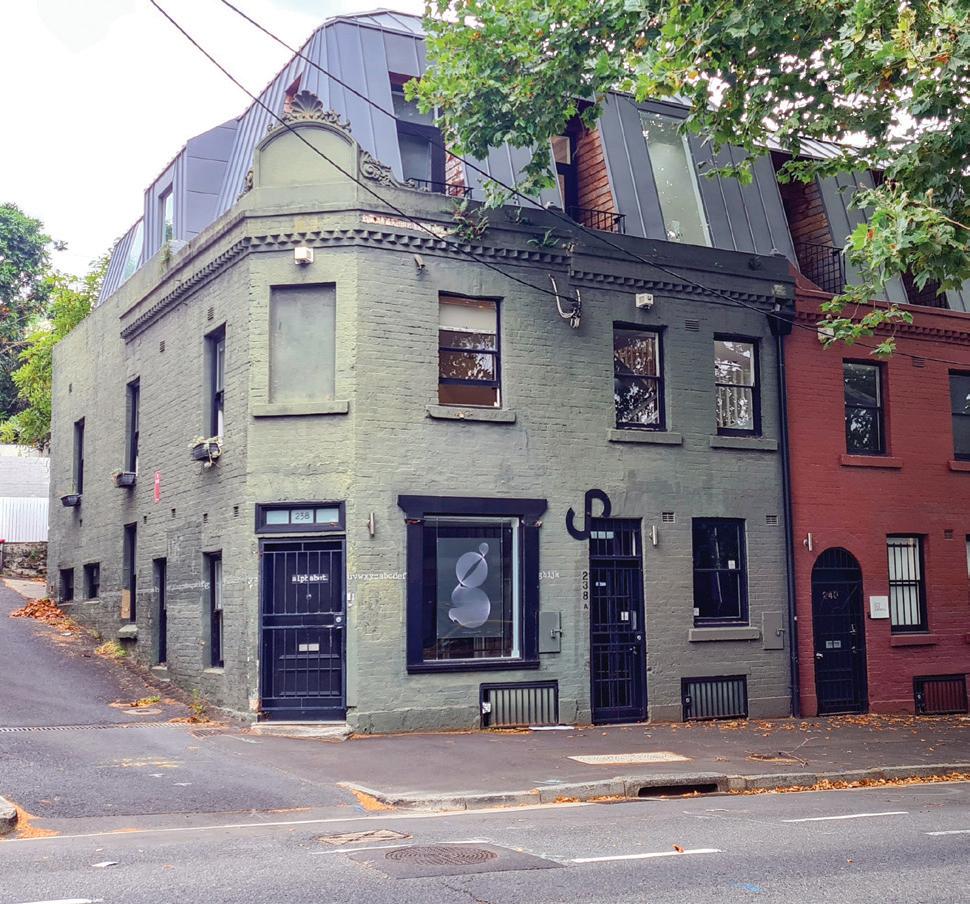
By Elliot Lindsay
43 Oxford Street
This inn was a popular meeting place for political speeches, social clubs, committees, etc. It hosted two coroners’ courts and was the scene of an explosion in 1878 when the spirits in the cellar ignited.
Crown & Davies Street
The original establishment on the site was Bluck’s Family Hotel. It was demolished and rebuilt in 1880, and a new name was adopted: The Golden Fleece Hotel. In 1890, the local gang, The Gipps Street Push, attacked the hotel. Nearly two hundred larrikins surrounded the hotel and smashed its windows with bottles and bricks, assaulting the publican and rioting on Crown Street for several hours. The government shut it down in 1923. Its old guest rooms are now apartments, and the former bar and billiards saloon is occupied by an optometrist.


Riley & Mackey Street
A popular little local hotel that hosted political meetings and a few coroners’ courts. It changed its name to the Commercial Hotel in 1887 and closed in 1893. Today, it is an office occupied by a graphic designer called ‘Alphabet Studio.’
Riley & Foveaux Street
The Mount View is a strange name for a hotel in Surry Hills; however, the rooms once had a clear view of the old sand hills of Moore Park, known as Mount Steel, Mount Rennie, Constitution Hill and Mount Lang. The hotel hosted the inquest over the death of Archibald McWilliam, who shot his wife in the shoulder and then himself in the head at 427 Riley Street in 1892. McWilliam was stored in the cellar until the coroner arrived. In 1923, the Government ordered the hotel to be closed. Today, its former guest rooms are apartments, and the bar is occupied by Grand Royal Barbers.
Albion
Originally established as Albion House Family Hotel, it has also been known as Farnham Arms and Mulvey’s Hotel. In 1895, the publican William McDowell was attacked by six members of the Gipps Street Push inside the hotel. The man was beaten mercilessly until a police officer arrived and flogged two of the larrikins with his club and dispersed the remaining thugs. The hotel was closed by the government in 1924. For the last fifty years, the building and the neighbouring five-lot terrace have been occupied by Tiffany’s Girls, claimed by some to be the oldest operating brothel in Sydney. As of mid-June 2024, the old hotel and brothel is on the market for $13 million.

“The Gipps Street Push, attacked the hotel. Nearly two hundred larrikins surrounded the hotel and smashed its windows.”
Reservoir
Named after the Surry Hills Reservoir, this iconic building was an upmarket hotel in the nineteenth century; however, when taken over by the known criminal Charles Henry Sorlie, it became a den of vice frequented by thugs and prostitutes. In Dec 1919, two men began arguing in the front bar; they took it out into the yard. The argument escalated into a brawl, and the next moment, guns were drawn, and a shootout began. Several shots were fired, and one shot grazed a man’s temple. They stopped shooting, put their guns down, and lingered in the parlour until leaving the hotel. As they walked out, one of the men was overheard saying, “We are all mates.” The NSW License Reduction Board was not impressed, and in September 1920, the hotel’s conduct was declared one of the worst in Surry Hills. The following year, the board had the pub shut down.
The hotel was then a boarding house, brothel, private hotel, and restaurant; it is now an office. In 1965, the artist Sali Herman painted the old hotel and entered the painting into the Wynne Prize. The Red House was chosen as the winner.





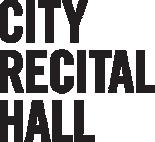





Classical, Contemporary, Conversations and more. Here’s what’s coming up at the Hall.

17 August Switched On: Ben Frost
30 August - 7 September Brandenburg: Handel’s House
3 October Omega Ensemble: Concertante
17 October Sydney Writers’ Festival: Jodi Picoult
18 October Switched On: Marcus Miller



At IGS, Unity Through Diversity is our vision for an equitable, inclusive and regenerative world.
Through bilingual learning and a global outlook, we seek to provide a blueprint for a better future.
Limited 2024 Kindergarten, Year 1 and Year 2 openings available.
←
New IGS Kindergarten Centre, designed by internationally renowned Australian architects BVN. Opening January 2025.



Scholarships and fee-assisted places available
Is your boy an independent, creative thinker? Then Grammar may be the ideal school for him. There is no waiting list and entry is based on merit alone. If families are worried about the fees, please note that Grammar offers a very extensive fee-assistance programme to help boys attend our School.
For more information about our Open Days and the Scholarship and Entrance Assessments, please visit www.sydgram.nsw.edu.au, or contact Tara Rennie at admissions@sydgram.nsw.edu.au.





The Albanese Government is making the Australian economy more prosperous and resilient We are putting our Future Made in Australia plan into action, so the nation makes the most of the major economic and industrial opportunities of the energy transition
The Future Made in Australia is also about supporting emerging technologies in industries like green metals, clean energy manufacturing and low carbon liquid fuels through the creation of an Australia Innovation Fund
The Albanese Labor government has ticked off a record number of renewable energy projects. And we have record numbers of renewable projects in the assessment pipeline: more than any other kind of project
In just two years, we have green-lit a record 54 renewable energy projects, enough to power over three million Australian homes.
In just two years, our government has ticked off more renewable energy than would be generated by 8 large nuclear reactors.
Labor is delivering cheaper, cleaner energy right now. Australians and our precious environment cannot risk waiting decades for Peter Dutton’s dodgy nuclear plan
The Coalition has spent a decade trying to kill off renewables and our transition to net zero. Now Peter Dutton’s reckless plan appears to be deliberately designed to put investment in renewables at risk
Thanks to a $1 billion investment by the federal, state and territory governments, and industry, we’re increasing Australia’s recycling capacity by more than a million tonnes each year
This includes $60 million for hard to recycle plastics like soft plastics Under the Recycling Modernisation Fund, we’ve funded 60 additional plastic recycling facilities and sixteen of these have already been delivered We’re also backing stronger rules on waste. Environment ministers have agreed packaging will be subject to strict new government rules aimed at cutting waste and boosting recycling, making sure packaging waste is minimised and we’re designing waste out from the start.
The rules will include mandatory packaging design standards and targets – including for recycled content and to address the use of harmful chemicals in food packaging.

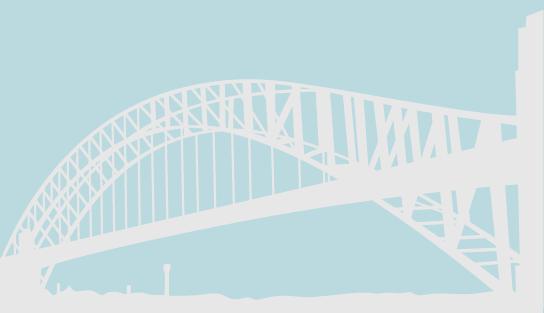


A
